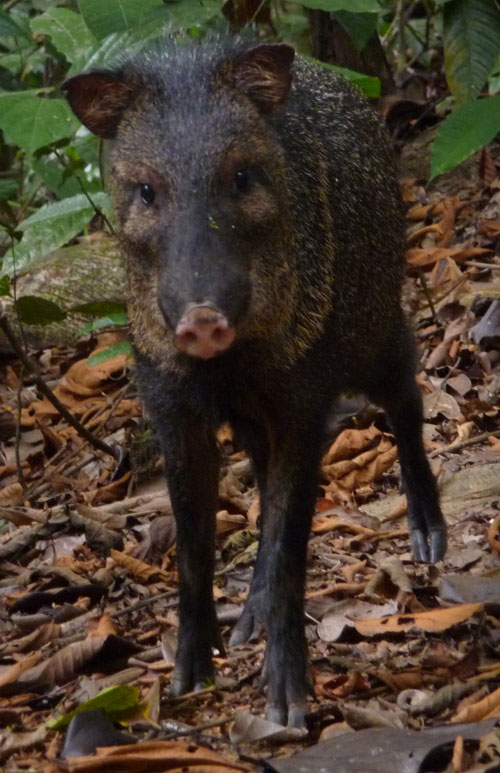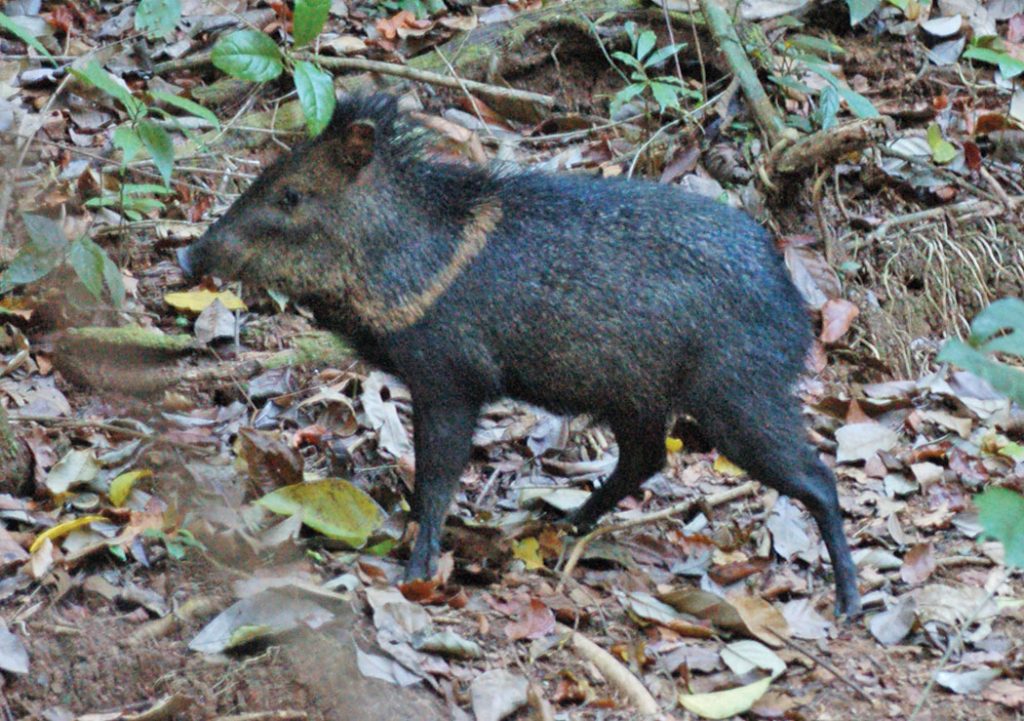Collared Peccary
Their Intelligence Rivals That of Monkeys
 By Jack Ewing
By Jack Ewing
Although I have lived at Hacienda Barú since 1972, I had never seen a peccary in the wild until 1997. Volunteers had come here, stayed a week or two, helped on environmental projects, and during that short time many of them had the good luck of seeing the collared peccary (Pecari tajacu), called zahinos locally. Our guides had seen them on numerous occasions as had our guests. My brother Rex came for his first visit in 14 years. He and his wife LaVonne did an overnight jungle camping tour with a sharp-eyed local guide named Deiner. I volunteered to carry the food up to the camp that afternoon. There had been a lot of collared peccary sightings recently, and I figured I had a good chance of seeing one during my hike up to the camp. I saw tracks everywhere and even caught a whiff of their musky scent. The ground had been dug up in several places where they had routed around with their noses for invertebrates, roots and tubers, but no collared peccary. When I got to the camp with the food, Rex and LaVonne couldn’t wait to tell me about the group they had seen, five of them.
“They were just a little way off the trail,” said Rex excitedly, “a big, dark, gray female and a couple of young. The babies were a reddish color. There were a couple more peccary farther back in the forest, but we couldn’t see them very well.”
“I don’t believe this. It’s unreal!” I exclaimed in exasperation. “I’ve been looking for a collared peccary for 25 years, and you see them the first time you go for a walk in the jungle. It’s not fair.”
 “It was really exciting,” Rex went on, oblivious to my ranting. “The female gnashed her teeth together till they clattered and kind of shook her head at us, but the little ones seemed curious. I was a little nervous but Deiner said not to worry. He had a big stick in his hand just in case they did something unexpected. The female stood about as high as my knee and had her lips curled, baring her tusks. She could do some damage if she took a notion to.” Rex went on to say that after a few minutes the big female led the group of zahinos off into the jungle. The two piglets followed reluctantly.
“It was really exciting,” Rex went on, oblivious to my ranting. “The female gnashed her teeth together till they clattered and kind of shook her head at us, but the little ones seemed curious. I was a little nervous but Deiner said not to worry. He had a big stick in his hand just in case they did something unexpected. The female stood about as high as my knee and had her lips curled, baring her tusks. She could do some damage if she took a notion to.” Rex went on to say that after a few minutes the big female led the group of zahinos off into the jungle. The two piglets followed reluctantly.
In my quest to find the collared peccary at Hacienda Barú National Wildlife Refuge, I often smelled them. Zahinos have a scent gland on their rump about a finger’s length above the tail. Rubbing the scent gland on a tree trunk and defecating and urinating at the base, is a method of marking territory. The smell is strong and musky. Another common sign of the presence of peccary are their small, sharp pointed tracks in the mud. These are similar to deer tracks, but are smaller and tend to point downward. On several occasions I was close enough to hear the characteristic alarm bark emitted by the collared peccary when excited. Once I surprised a big one that let out an enormous “hurummpf” that nearly scared me out of my wits. It then went charging off through the jungle “hummpf, hummpf, hummpf,” until it was out of hearing distance. All I got to see of that one was the movement of the foliage as the zahino forced its way through the low lying vegetation.
When it finally came my first sighting was no big deal. Three collared peccary ran across the trail in front of me and off into the rainforest. I only caught a glimpse of them, but I had officially seen them. From that day forward sightings have become much more frequent. Populations have increased due to diminished levels of hunting, and the peccary have become a little less spooky due to regular contact with nature lovers hiking on the trails. They still keep their distance, but don’t panic at the sight of humans.
To me the most amazing thing about peccary is that they still exist. Since the first humans appeared in the Americas, more than 10,000 years ago, wild pigs have been hunted for their meat and hides. Yet both Central American species and a South American species have managed to survive in reasonably large numbers, while many other heavily hunted mammal species have become extinct or nearly so. Both Costa Rican species, the collared and the white-lipped peccary, are considered threatened and are listed in appendix II of the CITES convention for the control of trade in endangered species. Large herds of the latter once wandered the wilds of Corcovado National Park. Lowered park budgets and ranger staff have resulted in an uncontrolled wave of poaching which has severely threatened the peccary and other species. In the area around Hacienda Barú National Wildlife Refuge, however, zahino numbers are higher than ever. This is due mostly to increased vigilance by private property owners.
In spite of the threat from human predation, peccaries range from Arizona to Argentina in every type of habitat imaginable, from dry desert to extremely wet tropical rain forest. In fact their adaptability has probably been their most powerful survival tool. In the deserts of Mexico and the southern United States, prickly pear is the collared peccary’s preferred food. In the humid Central American tropics, roots and tubers form the major portion of their diet. Palm nuts and other large seeds are also a favorite item. All peccaries will eat meat, but aren’t very well equipped to hunt and capture wild game. The protein in their diet consists mostly of large insects, snails and carrion.
Superior intelligence has also helped the peccary to survive. In 2010 when a new highway passed right through the middle of Hacienda Baru National Wildlife Refuge we managed to convince the highway department to build tunnels under the road to facilitate animal crossing, and diminish road kill. The collared peccary were the first species to use these subterranean crossings. In fact we found their tracks entering and exiting the tunnels even before the construction was finished. Considerable road kill of other species still occurred for about six months after the opening of the highway. Eventually most mammal species learned to cross under the traffic rather than through it and thus avoid death on the asphalt. With trail cameras we have documented 13 different species that cross through the tunnels, but the peccary were the first. I have never seen a dead peccary on the road. On the other hand it took the white-fronted capuchin monkeys over a year to start using the bridges we built over the highway. During that year about half a dozen monkeys died crossing the highway on foot.
Although peccary are related to domestic pigs and resemble them in many respects, their young are precocial, meaning they are able to walk and follow their mothers one or two days after birth, whereas new born domestic pigs are helpless for a couple of weeks. I captured a video on a trail camera of a female collared peccary and a very young and wobbly baby slowly following her through a tunnel. “From birth subterranean highway crossings have been part of this piglet’s environment,” I pondered. “New generations of mammals will grow up thinking of highways and subterranean crossings as a natural part of the environment. Before long all of the older animals that were here before the tunnels will have died, and entire populations of mammals will have been born into the current reality of crossing under the road.
Other than humans peccaries are preyed upon only by Costa Rica’s two large felines, the jaguar and the puma. At Hacienda Barú the puma is their only serious natural predator. I suppose it is possible for a hungry ocelot to kill a straggling baby, but babies seldom stray from their mother’s side, and I doubt if an ocelot would want to risk an encounter with a furious female’s tusks. It appears that in the area around Hacienda Barú there is an equilibrium between peccary numbers and predation. The population is high and appears to be stable. There are enough collared peccary here that I now see them regularly. There is better than a 50-50 chance that a visitor who walks through the Hacienda Baru National Wildlife Refuge on one of the trails for a couple of hours will see one.

